Peacock Springs
Peacock Springs is one of the best springs in Florida, and one of top cave diving sites in the world.
Peacock Springs offers a complex cave system and some of the best, most affordable and high-quality cave diving in the world.
Unlike other state parks, Peacock Springs doesn’t attract endless crowds. It’s well off of Florida’s beaten path, and it’s not for everyone.
Peacock Springs is located in a remote, rural area. It’s really best-suited for one activity; cave diving.
Be sure to do research before visiting, and know what to expect.
Note: Many dangers exist in Wes Skiles Peacock Springs State Park. All users are encouraged to exercise extreme caution and take all prudent safety precautions. Cave diving is extremely dangerous. Only properly experienced, properly equipped experts with first-hand knowledge of a cave system should ever consider entering an underwater cave.
Wes Skiles Peacock Springs State Park
Peacock Springs is located inside Wes Skiles Peacock Springs State Park. The rural state park is more natural and is much less developed than other state parks in Florida.
The Wes Skiles Peacock Springs State Park is truly a hidden gem in Florida’s state park system.
The park protects sensitive, important ecosystems. There are 5 second magnitude springs on the property, and miles of an amazing underwater cave network.
All of the waters inside the state park are designated as “Outstanding Florida Waters”. There are not any dry caves in the state park.
The Peacock Springs State Park is a world renowned cave diving destination. It’s at the top of many diving bucket lists.
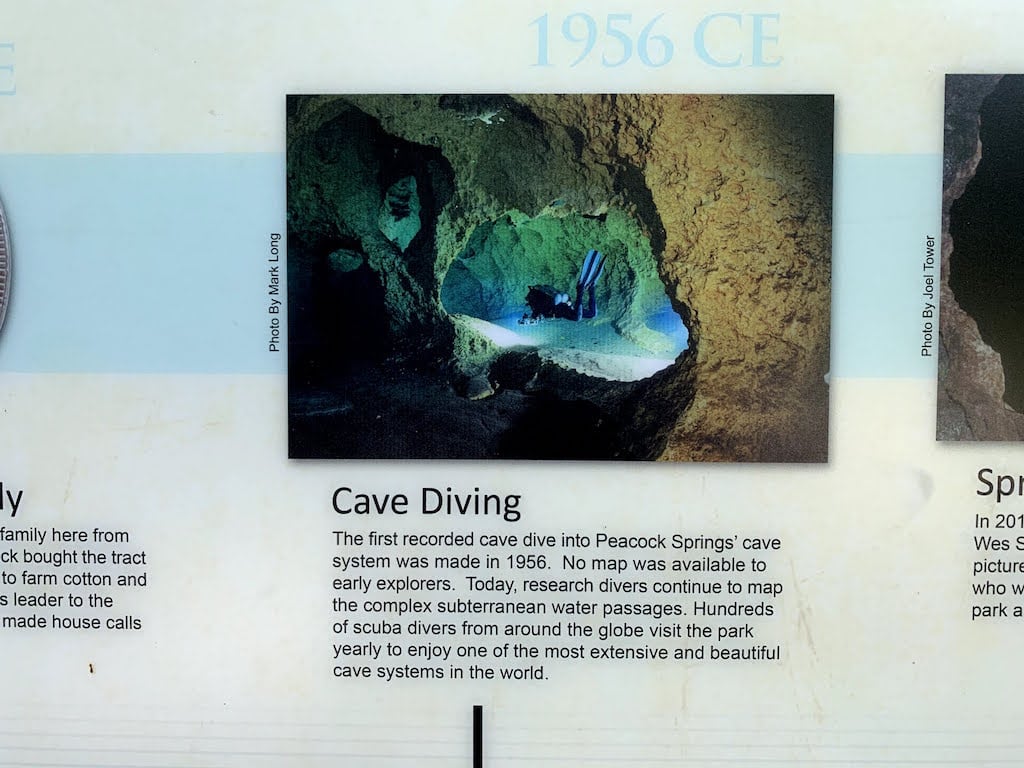
Peacock Springs is inland. It’s dozens of miles from the nearest ocean. So, it may seem unusual to find a parking lot packed with pickup trucks filled with air tanks and diving equipment.
But, it’s not unusual. For many, this is Florida’s SCUBA diving paradise.
Divers visit from all over the U.S. and the world. Visits have been documented from 6 continents and all 50 states.
Many divers prefer Peacock Springs over alternatives like Ginnie Springs for the affordable price, natural atmosphere and dramatically lower crowds.
Cave diving is the main attraction by far, but non-diving visitors come for other reasons, too. Visitors can swim, snorkel, observe wildlife and hike through pristine nature.
Above-ground information boards explain the extensive cave system, and visitors can view some cave features, like the beautiful Olsen Sink.
Things to Know
Visitors should be aware that Peacock Springs is primitive compared to other state parks in Florida. There are not any playgrounds, and there relatively few facilities.
- There is no potable drinking water inside the park.
- It costs $4 per car to enter the state park. Visitors should bring $1 bills.
- Some of the paths, trails, roads in the park are dirt.
- Roads and trails may be rough or muddy, especially after rains.
- Mosquitoes, ticks and other insects can be a nuisance.
- There are alligators.
The state park offers basic amenities.
- Grills
- Picnic Area, Tables and Pavillon
- Changing Area
- Restrooms (Composting drop toilets, and port-a-potties)
- Informational signs
Preservation experts agree that the sensitive and delicate karst geology of the land cannot support extensive development or infrastructure.
There are changing stalls and two primitive toilet areas. One toilet area has a composting toilet and the other has portable toilets.
Pets
Pets are allowed in the state park if they’re on a leash.
Pets are not allowed to swim, or near the water.
They should be kept under close control at all times because of rules and the presence of dangerous wildlife, including alligators.
Activities
“Two of the park’s water features, Orange Grove Sink and Peacock Springs, provide opportunities for swimming, snorkeling, and scuba diving.
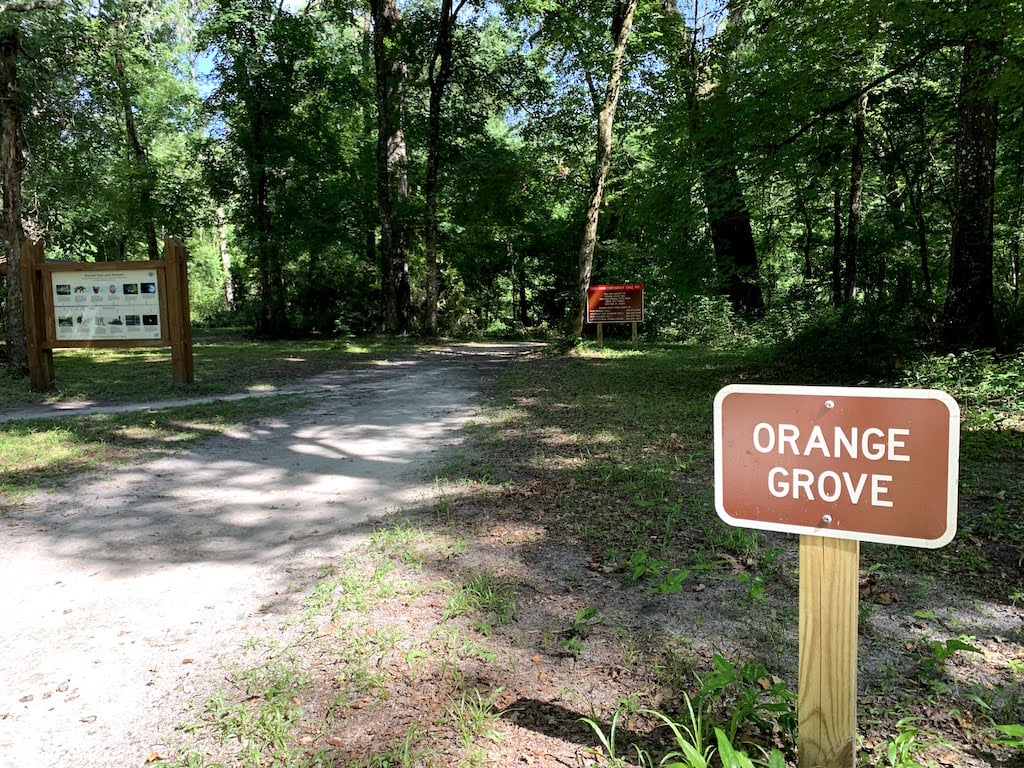
Swimming, snorkeling, and cavern or cave diving are suitable and permitted at both locations, while open water diving is only permitted at Orange Grove Sink.
Many dive training classes engage in open water diving at the Orange Grove Sink.”
Non-Diving Visitors
Diving is certainly the main attraction. But, there are other things to do, too. Non-diving visitors can participate in nature watching, geocaching, hiking, swimming and snorkeling.
Swimming
The springs are really best suited for divers instead of swimmers or snorkelers.
Most of the time these springs don’t look like good places to swim — at the surface, anyway. The swimming conditions can be bad enough to deter the most committed divers.
The spring pools are usually filled with a heavy carpet of neon-green duckweed and algae.
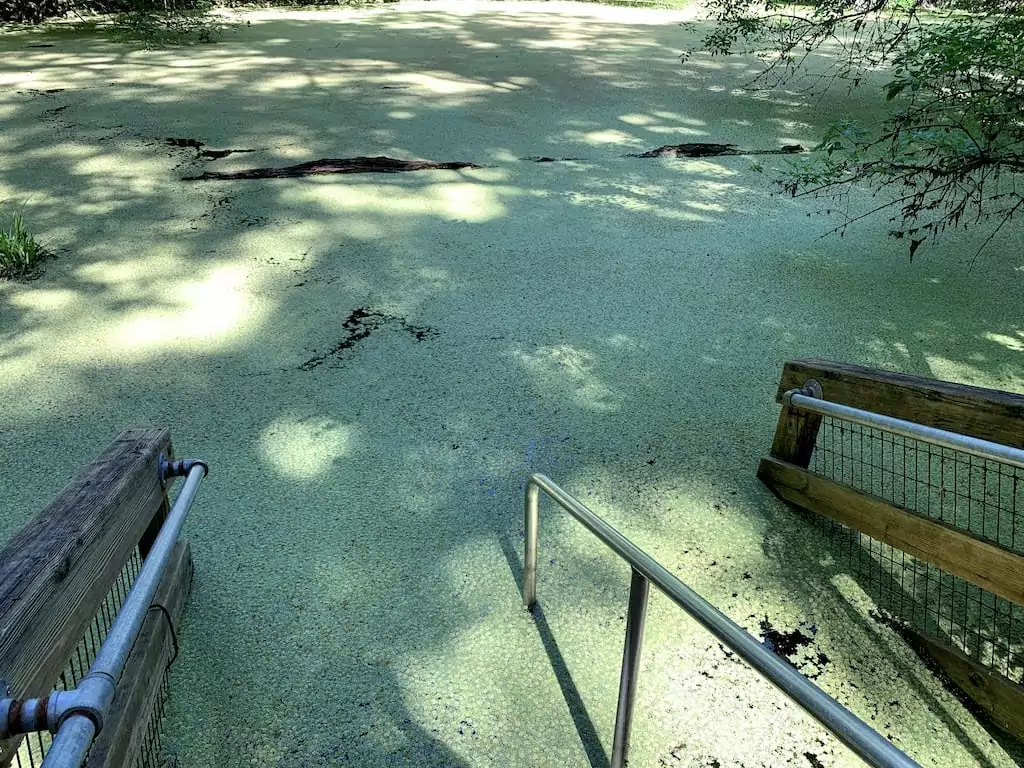
There are alligators in the waters of Peacock Springs State Park. They are commonly seen sunbathing on the spring banks.
Hiking Trails
A 1.2 mile hiking trail lets you trace the path of the underground cave from above. There is some shade on the trail.
Radio-frequency tracking equipment was used to replicate the cave route from above ground. The trail was created by the North Florida Springs Alliance.
There are informational signs along the way. The beautiful blue waters of Olsen Sink can be viewed from the trail.
Be aware that the trails are not as well-groomed or maintained as trails in other parks. They may be difficult for some people. They may be muddy, covered with leaves and debris and have holes.
Be prepared for the possibility of snakes, mosquitoes, insects, ticks and other natural wildlife.
When to Visit
In this section of north Florida, temperatures are extreme in both summer and winter.
Winters are not balmy like it is in south Florida. Chilly winter temperatures are normal, and it can drop below freezing.
Like all of Florida’s springs, the underground spring water remains 72 degrees year-round.
This area of North Florida experiences a bit of fall leaves color.
- Insects are worse during warm months.
- Summer days are longer, which allows for more dive time.
- Dives must be finished at least one hour before sunset.
- Diving is best early in the day before other divers stir silt or decrease visibility.
- Alligators and snakes are active during certain times of year, especially alligator mating season.
- Algae tends to be worse during warm months.
- Flooding usually occurs in the spring.
When the Suwannee floods it submerges areas of the park, and can flood the entire cave system. Floods can result in backward flow, brown-outs and may result in the springs being closed. Always check the official state park website before visiting.
Location
Peacock Springs is just north of the Suwannee River in Suwannee County.
It’s about two miles east of the sleepy town of Luraville, and about 20 miles southwest of the town of Live Oak. The town of Mayo is 5 miles south of the state park.
This park is special because of its geology and karst topography. The entire region is known as coastal lowlands. The land slopes gently toward the gulf coast, just a few dozen miles away. The is inside the Suwannee River Lowlands.
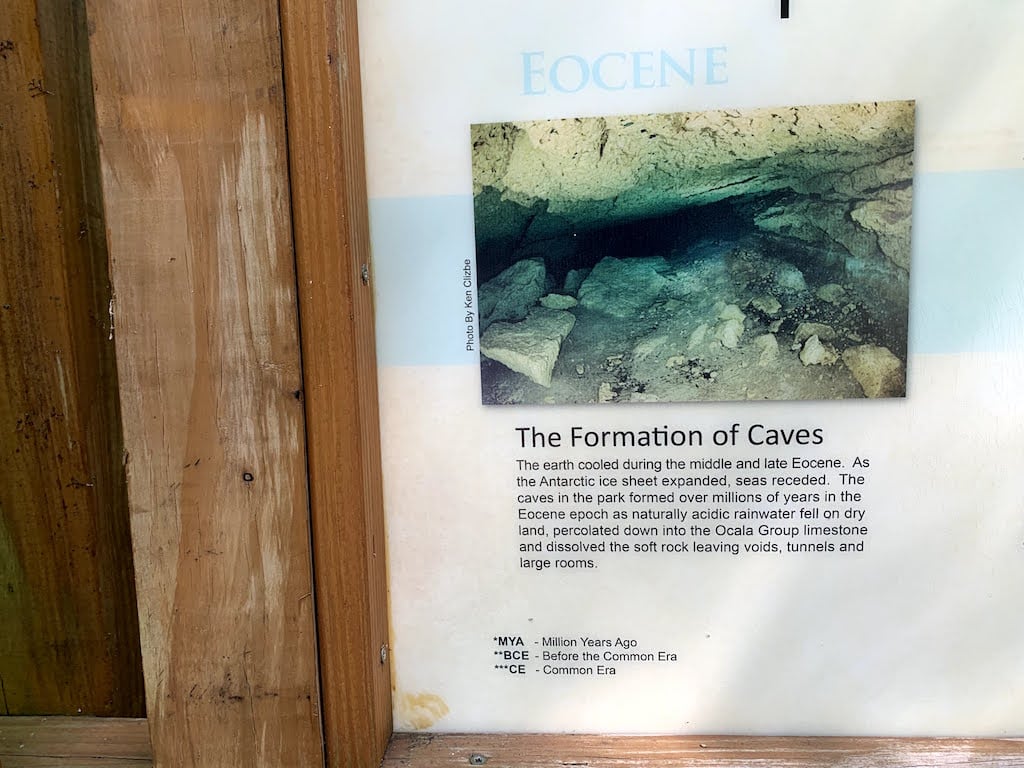
Limestone in this region is found just beneath the surface. It’s exposed in some places, and is only covered by a thin layer of clay or sand in most others. This mix of geologic force is perfect for creating caves, sinkholes and other karst features.
The layer of limestone can be up to 190 feet thick. It’s generally white to yellow-gray, with other colors and types of rocks mixed in.
Most of the park is inside the Suwannee River floodplain.
Local Area
This area is rural, so know what to expect and come prepared.
This area is just a few dozen miles south of the Georgia border. Some folks consider this to be on the eastern edge of the Florida panhandle.
This area of Florida is known as cave country. Why? Because there are hundreds of significant caves in this region, and countless more that we don’t even know about.
The geology of this area is uniquely well suited to cave formation, thanks to its karst geology. Porous karst limestone sits just beneath the ground. It’s completely filled with holes. Many people compare it to swiss cheese, or a sponge.
The ground is so riddled with holes that it’s difficult to maintain good roads in the state park.
Local Economy
In this region of Suwannee County cave diving and eco-tourism are two of the largest economic drivers. Other drivers include agriculture, forestry and some limited phosphate mining operations. Sadly, agriculture and phosphate operations pollute the water and damage the springs.
More than 20,000 people visit Wes Skiles Peacock Springs State Park each year. The actual number of visitors is likely higher than that.
Old estimates, which are surely much higher today, figured that by itself, Wes Skiles Peacock Springs State Park attracts about a million dollars of eco-tourism revenue into the region.
There are quite a few dive shops which are happy to outfit and train cave divers.
The area’s remote location is mostly a blessing to Peacock Springs. It helps keep the number of visitors manageable, and avoids overwhelming the sensitive natural environment.
It also offers the possibility of more affordable lodging, since real estate is cheaper than Florida’s more expensive diving sites, like the Florida Keys.
Lodging is often the biggest cost of traveling in Florida, especially because dive trips can tend to be longer than ordinary vacations.
One other good aspect about the rural location is that it’s easier to save money. There aren’t many options to splurge on expensive coffees or fancy dinners.
In the nearby town of Luraville, the famous Dive Outpost and Luraville Country Store can help sort out diver needs.
Luraville Country Store
For coffee, hot food, cold drinks, groceries, ice and other necessities, cave divers turn to the small Luraville Country Store.
It’s a fixture in the small community, and cave divers have made it home.
Folks are happy with the Country Store’s food, especially the sandwiches and burgers. The parking lot can be filled at times because it’s such a popular spot.
There are maps of the Peacock Springs cave system underlaid inside the dining tables. Outside, there’s a wall-sized mural and map of the nearby springs.
Cave Dive Training
The Peacock Springs system is immensely popular for cave diving training. Several instructors operate SCUBA training operations out of the spring.
The system is uniquely well suited for cave diving.
Its accessibility, complexity, length, and other favorable characteristics all combine to make it a world-class destination, especially for beginners and training.
Visiting divers also love that there are so many world-class diving spots within driving distance.
The Peacock Spring cave system is very long and relatively shallow. It’s one of the longest systems of caves in Florida, and the continental U.S. The exact length is unknown, but more than ten miles of the system have been mapped.
The water flow depends on current conditions, but is generally low. Divers don’t need to fight against raging water currents.
Note for Beginners
Many divers note that, even though Peacock Springs is a popular “trainer” site for cave divers, it should not be written off or underestimated. It is an amazing, sacred site, and should be treated with the utmost respect.
The site is dangerous, intricate, complex and fascinating. It’s just as memorizing, and potentially lethal, as any cave dive on earth.
Even after all these years and countless dives, new discoveries are still being made today. Even for experienced divers, every descent is a new experience.
Cave System Damage
Cave divers are generally a very conscientious group. They are disciplined, and are very deliberate about preserving the natural environment.
Thousands of volunteer hours have been logged in Peacock Springs, and the cave community helps support the park in many ways.
Still, the caves and natural environment are altered from visitors presence.
Various examples of damage include shoreline erosion, vehicle pollution runoff, handprints on cave walls, silt disturbance and other unintentional damage.
Even air bubbles can dislodge small cave organisms.
Equipment scrapes can be especially destructive. Narrow, high-trafficked passages are most vulnerable to this sort of damage. The caves with diver training seem to suffer more than experienced-only caves.
Cave System
The Peacock Springs cave system is a complex series of interconnected passages. More than 10 miles of passages have been mapped.
A great description of the cave system can be found on this site, along with amazing photography.
Karst Geology
Like all of the springs in Florida, these caves exist because of Florida’s karst and limestone geology.
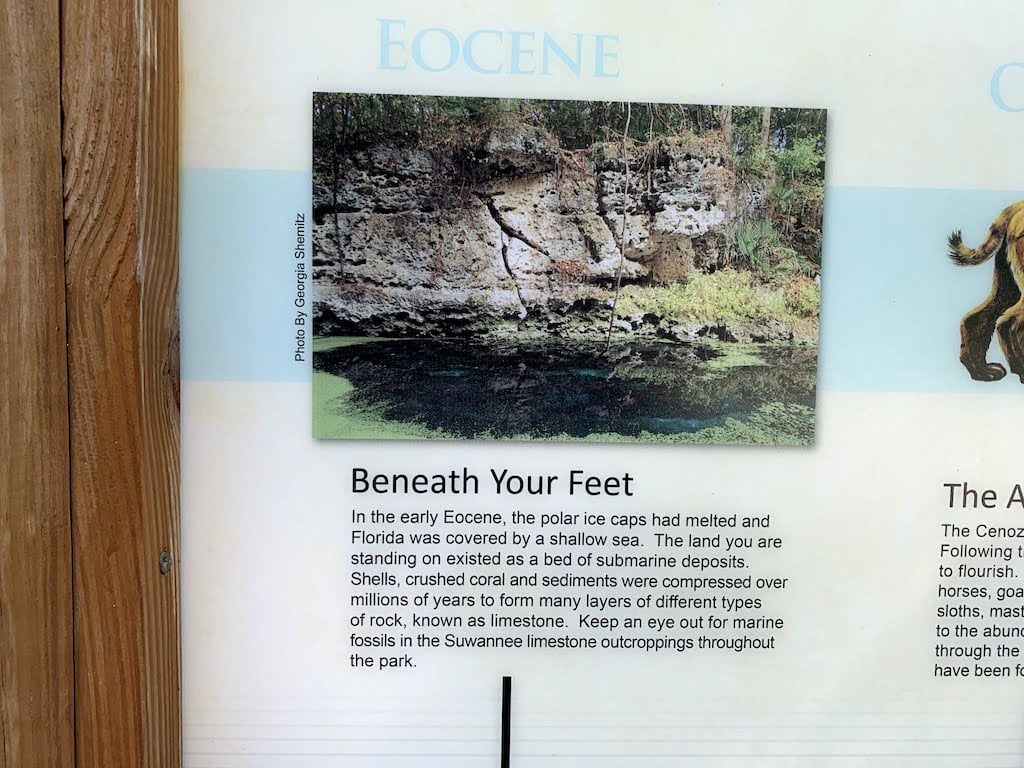
- Over time, rainfall mixes with organic materials like fallen leaves.
- The water becomes mildly acidic and seeps into the ground.
- Underground, the water slowly dissolves limestone through a chemical reaction.
- This happens because limestone is naturally basic, which is the the opposite of acidic.
This process creates an endless series of holes and tunnels. The rock formations are so porous and filled with holes, many say it looks like swiss cheese, or a sponge.
Many of the cave systems in this region have main, “trunk” passages, which smaller passages branch off of. This dynamic creates very complex water flow conditions.
Water and passages from the sinkholes and springs are intricately connected.
There are many karst windows, which are entrances into the aquifer. These provide a direct path for water runoff and pollution to enter the system.
Because of this, Peacock Springs is vulnerable to damage, pollution and groundwater contamination
The Peacock Springs system has relatively low water flow. The water may be stained dark due to natural tannins. This usually happens during and after periods of heavy rainfall.
Cave Openings
There are many karst openings, but only some are available for diving. Others are closed to protect the fragile ecosystems.
For the most up-to-date conditions and rules, visit the state park page.
“Olsen Sink is one of the most scenic and fragile sites within the Peacock system.
It is especially vulnerable to ever increasing recreational pressures.
Historically, Olsen Sink and Bonnet Spring both experienced significant amounts of soil disturbance due to divers and other visitors traversing the steep slopes above these sinkhole lakes.
Recreational diving has since not been allowed at Bonnet Spring and Olsen has only been used as an escape route for divers during an emergency ascent.”
There are many openings in the cave system.
- Pump Spring
- Baptizing Spring
- Walker Spring
- Challenge Sink
- Orange Grove Spring
- Cisteen Sink
- Olsen Sink
- Pothole Sink
- Bonnet Springs
- Waterhole Sink
- Peacock Springs 1
- Peacock Springs 2
- Peacock Springs 3
There is an intermittent spring run and a wampy floodplain corridor named Peacock Slough. It travels south for 1.7 miles and connects the Suwannee River.
Water usually discharges out of the springs and into the Suwannee River.
The river floods frequently. When it does, water can backflow and water can siphon into the springs. The river is polluted with high levels of nitrates and phosphates.
Flooding allows the river pollution to enter the springs, cave system and aquifer.
It ruins visibility and damages populations of sensitive cave-dwelling invertebrates.
Some cave system openings are accessible, and some are off-limits. The off-limit ones are treated as “emergency exit use only” to protect fragile environments and prevent damage from high-traffic.
“Two of the park’s water features, Orange Grove Sink and Peacock Springs, provide opportunities for swimming, snorkeling, and scuba diving.
Swimming, snorkeling, and cavern or cave diving are suitable and permitted at both locations.
Open water diving is only permitted at Orange Grove Sink. Many dive training classes engage in open water diving at the Orange Grove Sink.”
Florida Department of Environmental Protection
Peacock Spring 1 and Orange Grove are the main entrances for cave diving.
Peacock Springs 1, 2, 3
There are three springs named Peacock Springs, designated as 1, 2, and 3.
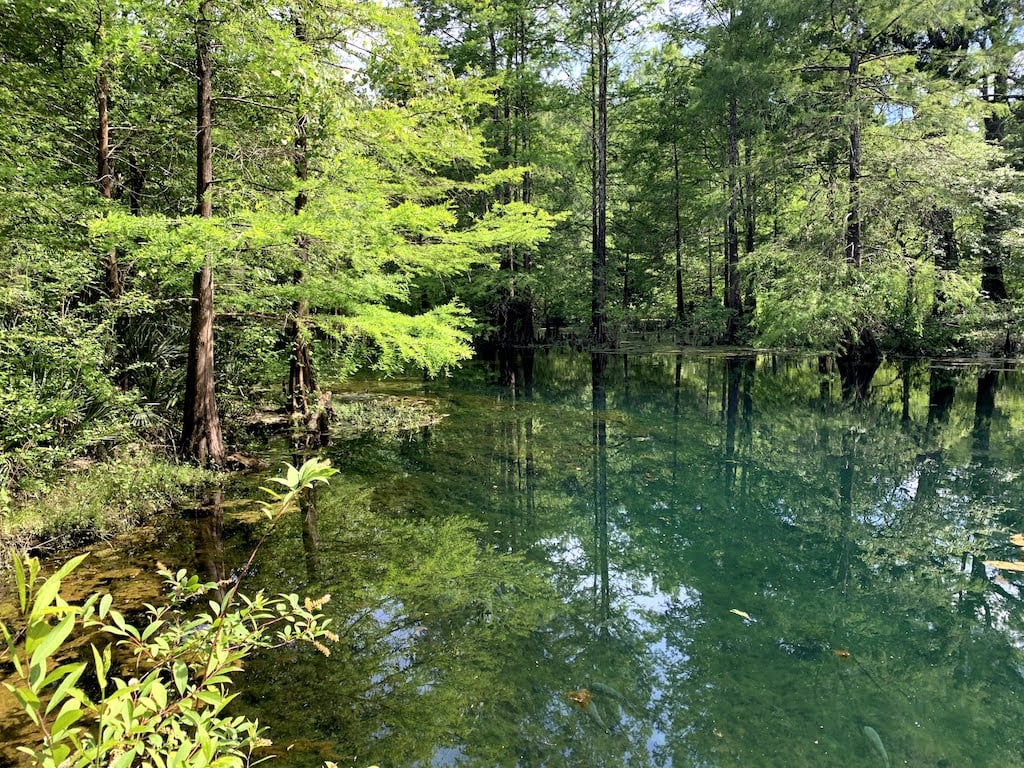
The three are interconnected karst windows. When water levels are high water flows out from them and they can act as “spring vents”.
Peacock Springs 1 is the busiest spring. It’s the easiest to enter and exit because of the stairs. The spring pool measures 150 ft long and 90 ft wide.
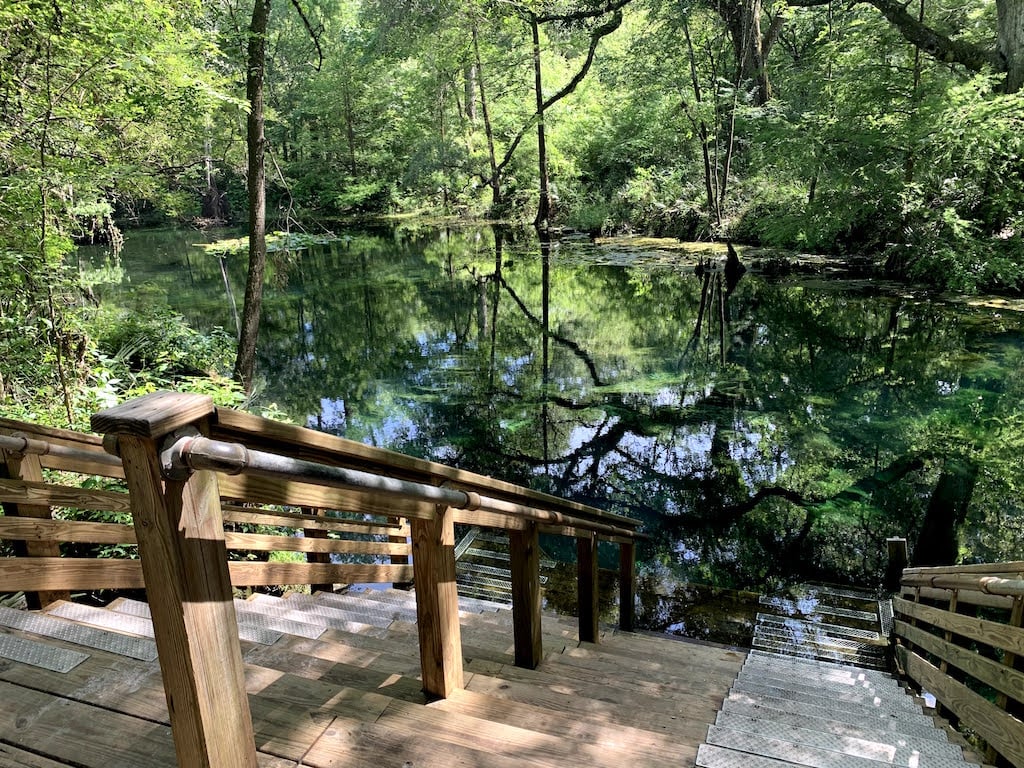
Depth of the spring varies. It averages 5 ft deep in much of the pool, but is 40 ft. deep in some areas.
The water is beautiful, blue and clear, but visibility can be worse at times due to rainfall conditions. The visibility is best inside the cave system.
The spring pool flows into a spring run when the water level is sufficiently high. The spring run is about 1 ft. deep and is approximately 15 feet wide. It flows into the Suwannee River.
Nice wooden stairs were built in 2001. A boardwalk connects the parking lot to the spring entrance and stairs, which descend into the water. The water is about 20 ft. deep where the stairs end, which sit on a ledge.
This was an essential improvement to stop shoreline erosion. Before the stairs were built, divers walked along muddy paths. This damaged the spring shoreline and reduced water quality.
Park managers also installed blockades to help divert polluted parking lot runoff and prevent it from entering the springs.
Olsen Sink
Peacock Springs is connected to Olsen Sink.
Many divers are excited to make a traverse between the two — i.e., to descend into Peacock Springs, and emerge up into Olsen Sink.
Divers should never exceed their training levels, and should always practice safe diving techniques.
Olsen Sink is a beautiful karst window. It’s stuck in the woods like a hidden treasure. The water is a beautiful, clear emerald blue, with impressive beautiful rock formations. It’s feels like a looking glass, aimed into the beautiful wonderland underground.
There is an observation deck for people to observe Olsen Sink; it’s accessible via the hiking trail.
“Swimming and diving activities are currently not permitted at several surface waters in the park, such as Pump Spring, Baptizing Spring, and Olsen Sink.
Due to their undisturbed condition, these features provide exemplary opportunities for wildlife viewing and nature study. Visitors can observe alligators, turtles, and other native species in their natural habitat.” Source
Orange Grove Sink
The Orange Grove sink is often covered in duckweed. Alligators are common. The duckweed makes it less attractive for general swimming, which helps keep the park attendance lower.
Challenge Sink
This sink is closed, and is only for emergency use. The banks of the sink are steep and access damages the fragile site.
Bonnet Springs
Bonnet Springs is a separate cave system on the Peacock Springs State Park property.
It’s the only known entrance to a separate cave system. It is probably hydrologically connected to Peacock Springs and the other systems.
Bonnet Springs is kept locked because it’s an advanced dive, to protect the sensitive system, and because of alligator activity.
Park rangers may grant access to qualified divers. There are strict experience requirements, including previous knowledge of the system.
Water Hole
Water Hole is two hundred feet west of Peacock 1. There is a trail from the wooden stairs.
Duckweed usually covers the spring.
The passage to Water Hole has interesting geological features like fissure cracks and bedding plains.
History
There is a historical timeline displayed inside the state park. This page contains some information about the park.
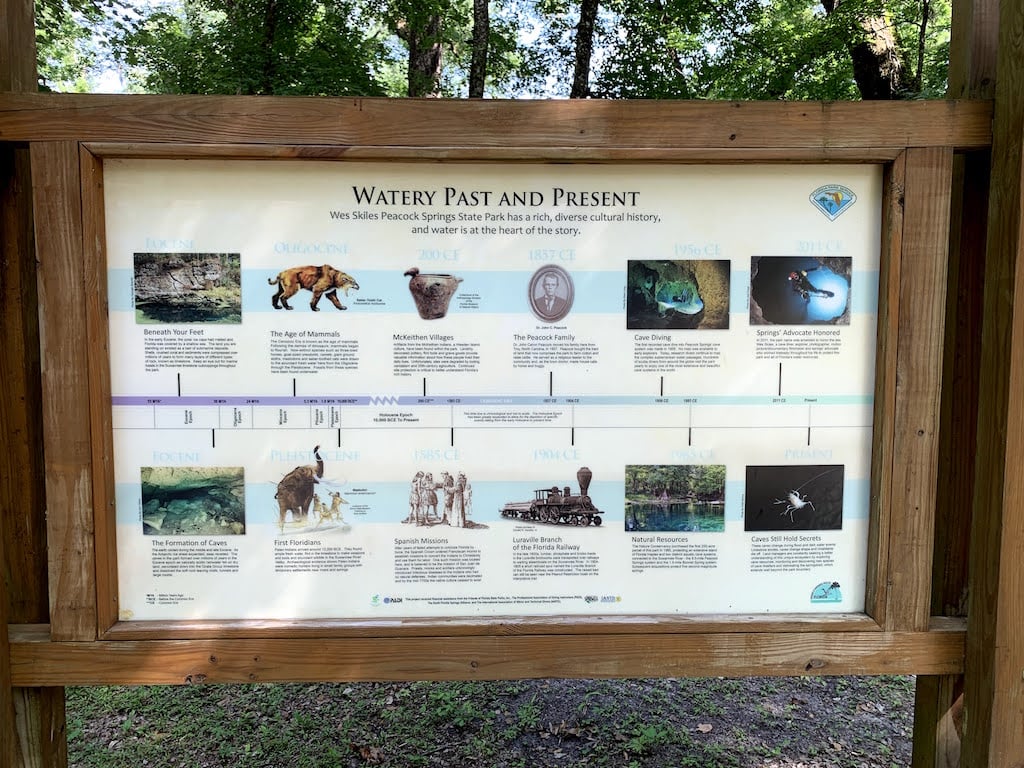
This area of North Florida was first settled by modern residents in the 1800s.
Before that, it had been inhabited for millennia by native americans and paleo-Indians. For a time it was the site of a Spanish mission, which tried to convert the local indigenous people.
This seems to be a question, but it appears as if the mission was abandoned around the year 1656 due to an uprising by the native Timucuan people.
There have been several archeological investigations inside the park and many archeological finds. Some date back thousands of years. Ancient fossils are embedded throughout the cave system walls.
Dr. John Calvin Peacock
Peacock Spring is named after an early landowner, Dr. John Calvin Peacock. He came to the region in the late 1800’s.
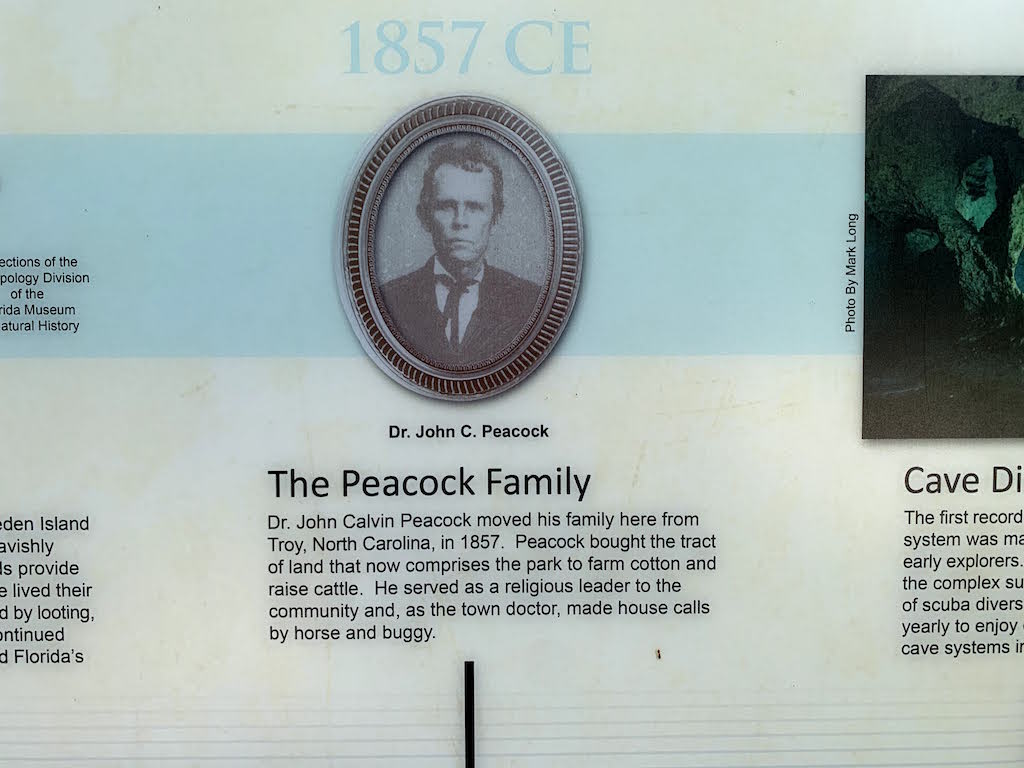
Suwannee County was established in 1858. Prior to that, the first permanent European settlers after the Spanish Mission period were the Reuben Charles family.

Mr. Charles established a trading post in 1824 at Charles Spring on the Spanish Trail about six miles from the present-day park.
In 1857, Dr. John Peacock and his family moved to the area and established the town of Luraville.
Dr. Peacock purchased lands that included the slough connecting the springs to the Suwannee River (Exley 2004).
Today this area is known as Peacock Slough and the park is named for the Peacock family.
Dr. Peacock owned the land around what is now Peacock Springs.
Peacock wore several hats in the small community, which had less than a hundred residents. He served as the preacher, doctor and was also a cattle rancher.
The springs were popular hangout spots. People swam in the cold spring, relaxed, and tried to hide from Florida’s hot, humid summers.
The springs were also used to perform baptisms, and a source of drinking water.
In the 1800s the regional economy was driven by brick making, timber, phosphate mining and a connection to the railroad.
Further downstream the Suwannee River, communities like Cedar Key were important trade ports. Steamships sailed up and down the river.
The state park’s name was changed in 2011 to honor the late Wes Skiles, who was a legendary cave diver and dedicated protector of the springs.
History of Ownership
In 1985 the Nature Conservancy bought 250 acres of Dr. Peacock’s old land. The State of Florida bought it in 1993 and opened it to the public.
The underwater passages of Peacock Springs were first explored in the 1950s, when recreational SCUBA diving was in its earliest days. The first dive in Peacock Springs was performed in 1956.
This era was a heyday for underwater cave exploration and SCUBA diving; both were still very new. Jacques Cousteau had first tried his Aqualung device only a few years earlier in 1943.
Before becoming a state park this land was used for agriculture. Sadly, the sinkholes were used for garbage dumping, as many are. The sinkholes were cleaned up and restored when acquired by the state. Some restoration still may need to be performed.
In the west section of the park there is a spoil mound from when a previous owner tried to enlarge a sinkhole by excavation.
The park has been expanded over the years. Today the park covers 760 acres. There are additional conservation lands nearby.
Nature
Peacock Springs is most famous among cave divers, but nature lovers also appreciate the state park.
On the property, visitors can see a variety of local Florida wildlife:
- Turtles
- Snakes
- Beavers
- Freshwater fish
- Alligators
- Birds
- Deer
- Bobcats
- Raccoons
- Squirrels
- Beavers
- Otters
- And more
Rare, unique animal species live inside the cave, including four species of imperiled cave-dwelling invertebrates.
Some have adapted to life inside the cave and have lost their eyesight. The American eel, cave crayfish, redeye club and Florida cave amphipod all live inside the cave system. These rare creatures are extremely vulnerable to disturbance, pollution and water quality.
This area is excellent for bird watching. This part of the Florida Bird Trail is a busy spot on many bird and butterfly migratory paths. Butterfly viewing is said to be spectacular in spring and summer.
The old-growth forest is also impressive. It has native maple, pine and other species.
Occasional manatees may be spotted on a nearby section of the Suwannee river. But, the river is not directly connected, or accessible from the state park.
Water Quality
The Peacock Spring cave system is sensitive, and vulnerable to degradation in many forms:
- Nutrient Pollution
- Erosion
- Sedimentation
- Low Aquifer Levels
Agricultural activities around Peacock Springs, especially fertilizer use, have been shown to directly contaminate the system’s groundwater and the nearby Suwannee River.
Scientific evidence now clearly indicates that agricultural activities surrounding Peacock Springs have played a significant role in long-term contamination of the groundwater (Cohen et al. 2007). This contamination has direct links to inorganic sources and specifically to agricultural fertilizers (Maddox et al. 1998). Source
Nearby Attractions
This rural area offers many opportunities for natural recreation.
The Peacock Slough Conservation Area is just southwest of the Peacock Springs State Park.
It’s owned by the Suwannee River Water Management District. There is a continuous wildlife corridor from the park boundary to the Suwannee River.
It offers recreational opportunities for wildlife viewing, bicycling, hiking, and horseback riding. It also provides a connection to the Suwannee River Wilderness Trail.
The Suwannee River Wilderness Trail is a 204-mile recreational trail located approximately one mile south of the park boundary.
The trail spans from White Springs to the Gulf of Mexico. It connects five state parks and other recreational areas along the way.
The trail includes opportunities for hiking, biking, horseback riding, and paddling.
For camping, there are six river camps along the river. They may only be accessible from the river. They provide screened sleeping areas and hot showers for overnight trail users.
Nearby Camping and State Parks
There are three state parks within 15 miles of the park.
Lafayette Blue Springs State Park is located five miles west of the park. It offers freshwater boating, canoeing, kayaking, fishing, scuba diving, hiking, wildlife viewing, picnicking, primitive and group camping, and cabins.
Troy Spring State Park is less than 15 miles east of the park along the Suwannee River Wilderness Trail. Troy Spring State Park is a day use park that offers freshwater activities, including boating, canoeing and kayaking, fishing, swimming, snorkeling, and scuba diving, as well as hiking, horseback riding, and picnicking.
The Suwannee River State Park is also less than 15 miles east of Wes Skiles Peacock Springs State Park. It offers freshwater and trail activities as well as overnight accommodations including cabins and full-facility camping. Source
Other Nearby Attractions
10 miles from the park, Allen Mill Pond Conservation Area features a second magnitude spring. It also offers bicycling, fishing, hiking, and horseback riding.
Falmouth Spring is less than 15 miles from Peacock Springs State Park. It features a first magnitude spring of spectacular quality and offers swimming, picnicking, wildlife viewing, hiking, bicycling, and horseback riding.
Mallory Swamp is also less than 15 miles from Peacock Springs State Park. It offers opportunities for wildlife viewing, fishing, hunting, bicycling, hiking, horseback riding, and ATV trails.
Twin Rivers State Forest is nearby. It offers nature study, picnicking, hiking, bicycling, horseback riding, canoeing, and fishing, along with primitive camping and hunting opportunities.
Sources and Additional Resources
- Florida DEP Informational Report
- The Cave Atlas has compiled user comments over time
- Florida DEP
Nearby Cities
- Branford
- Lake City
Region
- Central Florida
- Florida Panhandle
- North Florida
- Northwest Florida
Activities
- Hiking
- Picnicking
- SCUBA Diving
- Snorkeling
- Swimming
Camping
Nearby Camping
Related Spring Group
Suwannee River Springs
Contact Information
- State Park: 386-776-2194
- Park Ranger Cell: 352-575-3996
- Nearby Lafayette Blue Springs Office: 386-294-3667
- Park Manager: 386-397-0921
- Peacock Springs is located inside the Wes Skiles Peacock Springs State Park.
Location
Address: 180th St, Live Oak, FL 32060
Directions
From the junction of SR 51 and Luraville Road in Luraville:
- Drive east on Luraville Road for approximately 2 miles.
- Luraville Road will take you to the entrance of Peacock Spring State Park.
